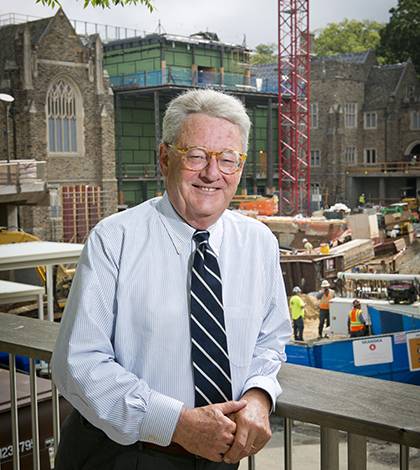Construction Q&A with Tallman Trask
Duke's executive vice president talks about recent construction boom

Since arriving at Duke in 1995, Executive Vice President Tallman Trask has been an influential voice for campus architecture, commissioning Duke’s master plan in 1997 and helping to guide dozens of capital projects. Over 20 years, Trask has overseen new construction, including the Nasher Museum of Art, and transformative renovations like Smith Warehouse. In 2003, he was elected as an honorary member of the American Institute of Architects. Given his involvement in more than 50 major projects on campus, Working@Duke sat down with Trask to learn about what recent construction means for Duke.
Why is Duke experiencing a construction boom?
This is currently the biggest construction boom since Duke was built, and a lot of things being done now are repair work that needed to get done on an 85-year old campus. We’ve tried to manage construction over the years so there’s a fairly common amount going on across time, but we got clobbered financially in 2008 because of the recession, so everything got pushed off the front burner. But the economy rebounded, we got a Duke Endowment gift, and philanthropy began to flow, so we wound up having more going on at once than we’d like to have, but that’s the nature of how it fit together.
Read MoreWhat is Duke’s approach to construction?
A large part is redoing things that had been built between 1928 and 1932 that have not had much attention. We discovered issues in some buildings, like the Chapel ceiling or our libraries not being waterproofed, that go back to original construction. That wasn’t so much the problem with West Union, but it wasn’t the kind of space you wanted as the central gathering space on West Campus. Taking it apart and putting it back together was a big objective, but a necessary one to make it a modern facility.
There are also little things. All the buildings on West Campus are roofed with a specific Ludowici clay tile, which comes with a 75-year guarantee. Ours is now 85 years old, and we have 10 acres of roof tile across campus. We’re working with the factory in Ohio to have new tiles made to mimic their current look to keep it the same.
How does this restoration impact campus?
We’ve done a good job of keeping Duke’s original appearance, which is intentional. By the time we’re done redoing our old buildings, we don’t want anybody to know we did it.
We’re also excited about what’s to come. The Arts Building is going to make a huge programmatic difference, along with Nasher Museum, to create an arts zone on campus. Paying attention to the arts was a big commitment in the last strategic plan.
Ultimately, it’s not about the buildings themselves, but what goes on in the buildings. We’re trying to create spaces that provide a better educational experience for undergraduate and graduate students.
What has it been like overseeing this amount of work?
Trying to manage this much construction at any given moment is not simple, but I’m proud that we haven’t imploded with so much going on. More or less, once we’re done with these projects, we have the facilities we need for the next several decades. The important thing to keep in mind is it’s almost over. The end is in sight.